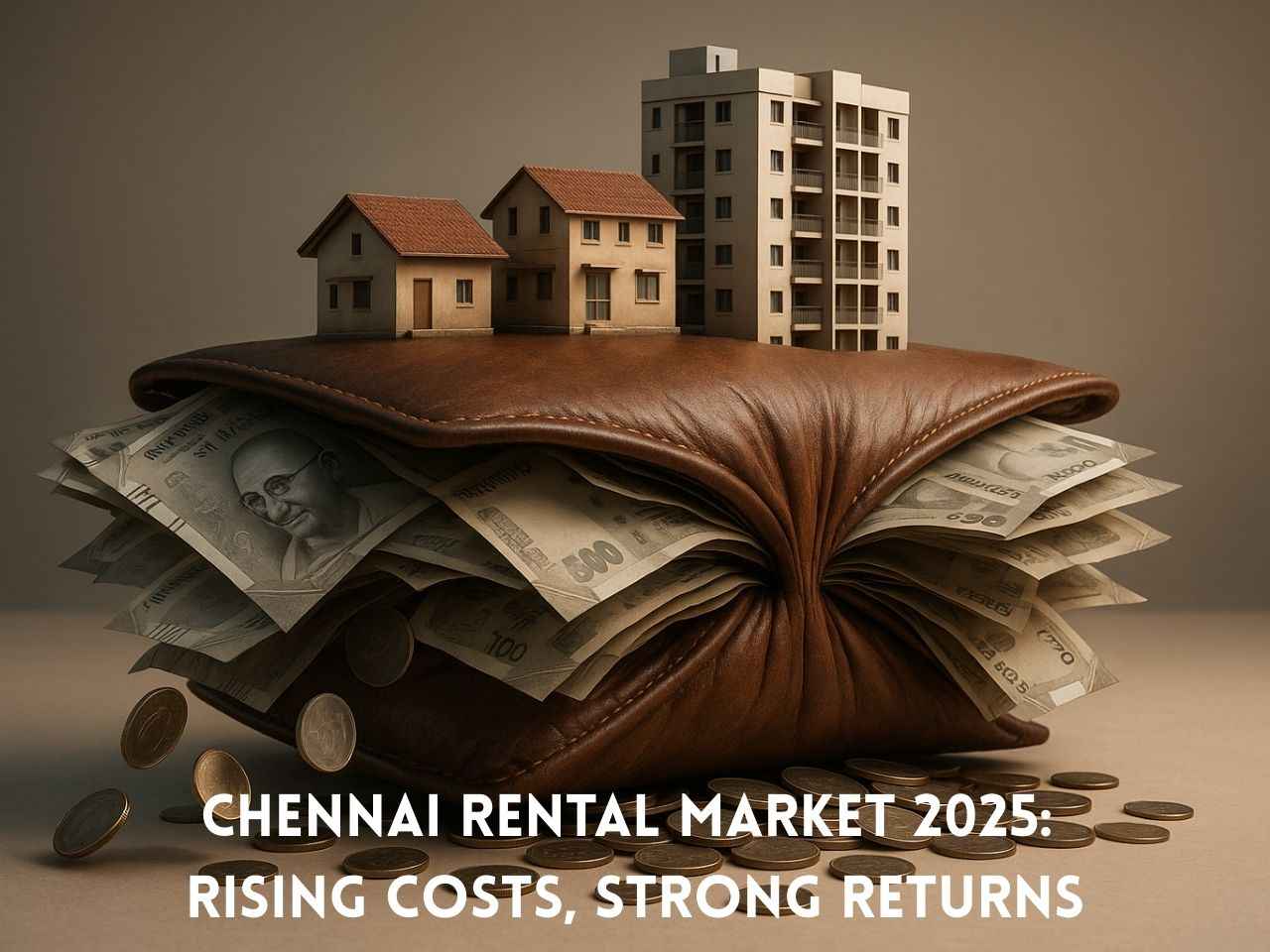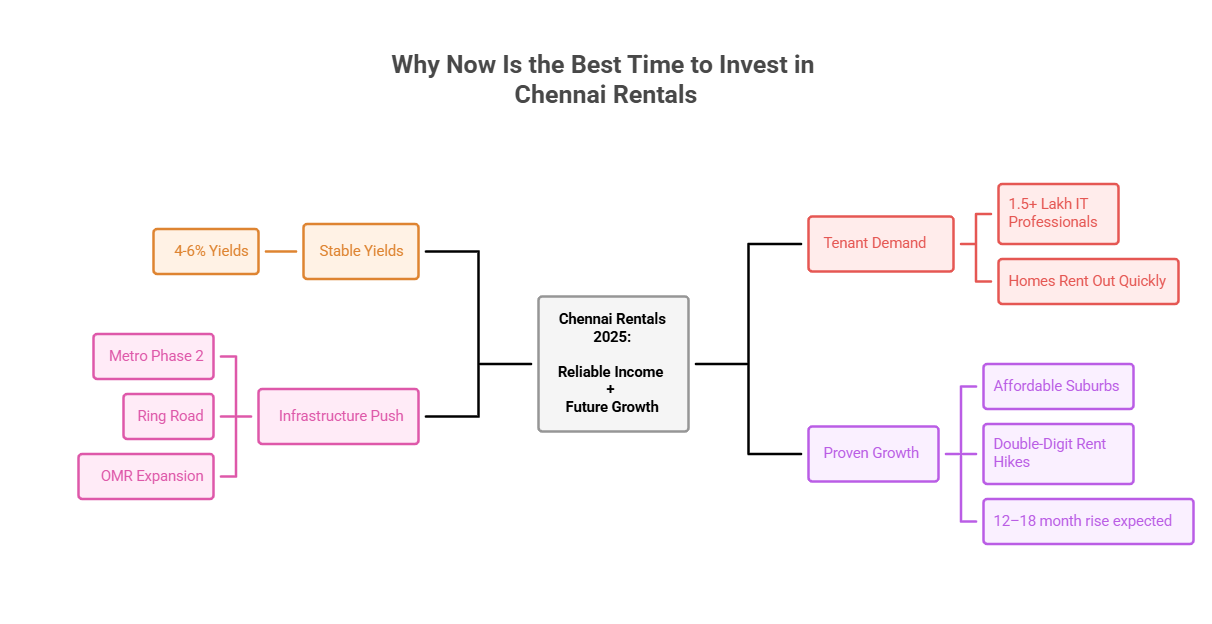
Rents aren’t just inching up in Chennai, they’re climbing at a pace the city hasn’t seen in years. If you’ve tried renting a flat this year, you probably know the struggle. That perfect 3BHK you had your eyes on? Chances are, five other families are eyeing it too, and the rent is far higher than what it was just a year or two ago.
It’s not your imagination. Rents in Chennai are soaring in 2025. For tenants, this means stretching monthly budgets. But for investors, it’s a clear signal that Chennai’s real estate is one of the most rewarding markets to enter right now.
If you’re still weighing between buying a flat or renting, it may be worth seeing why now is the right time to buy a home in Chennai, especially as rents continue to climb.
During the pandemic, rentals slowed as remote work reduced the need to live near offices. That trend has now reversed. With most companies back to on-site operations, proximity to the workplace is once again a top priority.
Chennai’s rise as a hub for Global Capability Centres (GCCs) has made this shift even stronger. With more than 250 GCCs employing 1.5 lakh professionals, housing demand has intensified around OMR, Guindy, Taramani, and Velachery.
For renters, this means more competition for the same homes. For property owners and investors, it means steady occupancy and higher rental returns. Back to work in Chennai has become one of the strongest triggers for this rental boom.
One of the biggest shifts in 2025 is that rental hikes are no longer limited to the IT corridor, they’re spreading across almost every part of Chennai.
Take Velachery. Once a mid-market choice for young professionals, it has now moved firmly into premium territory. Even compact one-bedroom apartments here cost well over ₹22,000 today. Adyar and T Nagar now see mid-sized apartments renting above ₹50,000, shifting what was once considered “regular rent” firmly into the luxury bracket. This shift is blurring the line between standard rentals and affordable luxury in Chennai real estate, a trend that’s reshaping buyer and renter preferences alike.
On the northern side, Madhavaram has quickly become one of the fastest-moving suburbs. With the metro improving connectivity, demand for Flats in Madhavaram has surged, and rents here are already up by about 11%. It’s a reminder that infrastructure projects like the TN Tech City in Madhavaram can completely change the perception of a locality.
Even the so-called “affordable” zones are catching up. In Poonamallee and Pattabiram, 2BHK units that once rented for about ₹10,000 now cost closer to ₹20,000. For a middle-class family, that kind of jump can mean choosing between a smaller home in the city or a larger home further out. For investors, it signals strong appreciation and steady rental income.
The takeaway? Rental growth is now city-wide. Whether in central, semi-central, or suburban pockets, every area connected by jobs and infrastructure is seeing a surge. According to industry studies, this trend isn’t slowing down, it is expected to continue as connectivity improves and more families look for well-located homes. In fact, Chennai’s rental growth is now among the fastest in South India, outpacing even Hyderabad and Bangalore in some suburban zones.
To know more about how metro expansion drives real estate values, read:
Chennai Metro Projects Drive Real Estate Prices Upward.
Nearly 70% of renters now prefer gated projects over standalone houses because they offer safety, elevators, reliable utilities, and community living. If you’re exploring this lifestyle, here’s why gated community apartments are in demand.
With hybrid work setups, families need the extra room, for a home office, children’s study space, or visiting relatives. What was once a luxury is now a necessity.
Tenants are prioritising projects with modern amenities like gyms, play areas, and common spaces that support community living.
Bottom Line: Demand is strongest in growth corridors like Medavakkam, Porur, and Siruseri, where modern projects offer both space and connectivity at more affordable rates compared to central Chennai.
If there’s one factor driving Chennai’s rental surge, it’s connectivity. New metro lines, ring roads, and the IT corridor expansion are changing how families and professionals decide where to live.
Take Madhavaram. A few years ago, it was often dismissed as “too far north.” But with Metro Phase 2 bringing it closer to the city centre, families now see it as both affordable and well-connected. Naturally, rents are climbing as demand grows.
The same pattern is visible in the west. Porur and Poonamallee are no longer seen as just budget-friendly zones. With metro access and road links, they have become magnets for tenants who want reasonable prices but still need quick access to IT parks.
Down south, the OMR stretch continues to push beyond Siruseri into Kelambakkam and Padur. As jobs follow, so do tenants, and rents here are already gearing up for 15–20% hikes.
The bigger story is this: yesterday’s outskirts are today’s prime rental markets. Tenants are willing to move slightly further out if it means faster commutes and better value. And for investors, that shift translates into higher rental yields and long-term capital appreciation.
For tenants, rising rents mean tougher choices. For investors, Chennai offers a rare alignment of factors that make the market more attractive than ever:
Returns in the range of 4–6% remain consistent, higher than averages in metros like Delhi or Bangalore, positioning Chennai among the strongest rental markets in India.
With over 1.5 lakh professionals employed in IT and GCCs, housing demand is continuous, keeping vacancy levels low.
Large-scale projects such as Metro Phase 2, the Peripheral Ring Road, and the OMR corridor expansion are strengthening connectivity, steadily pushing property values upward.
Localities that were once considered affordable are showing double-digit rental increases.
A 2BHK currently rents for ₹10,000 – ₹13,000. With industrial expansion and new road links, these homes are projected to see up to a 25% increase in rents, offering investors both near-term rental growth and long-term asset appreciation.
In summary, Chennai’s rental market is not just resilient, it is expanding in both breadth and depth, offering investors the twin advantage of reliable income and capital growth.

Visual summary of the key reasons why now is the smartest time to invest in Chennai’s rental market for steady returns and future growth.
Chennai’s rental market in 2025 is sending a clear message: demand is rising, infrastructure is expanding, and opportunities are widening. Whether you’re exploring Properties in Chennai for rental income or long-term growth, the market is showing strong momentum.
Across the city, from fast-rising suburbs like Madhavaram to southern corridors such as Kelambakkam and Siruseri, every connected neighbourhood is becoming part of the growth story. The question is no longer whether Chennai’s rental market will grow, it already is.
The real question is: will you position yourself to benefit from it?
![]()